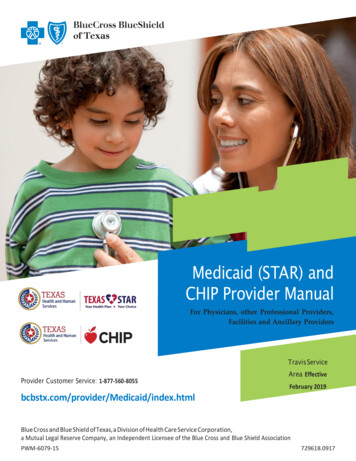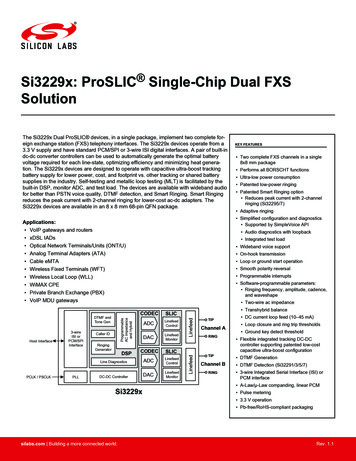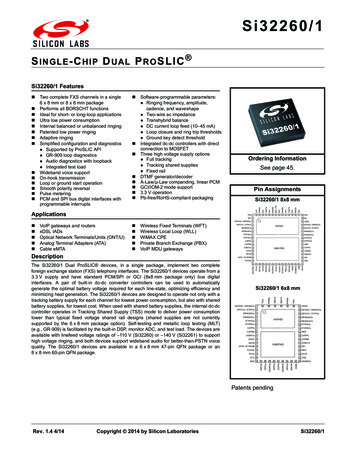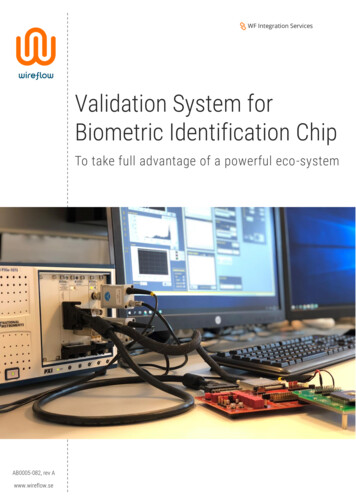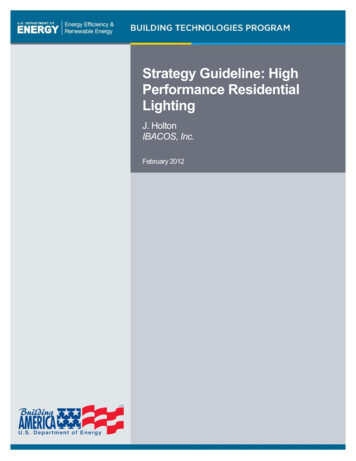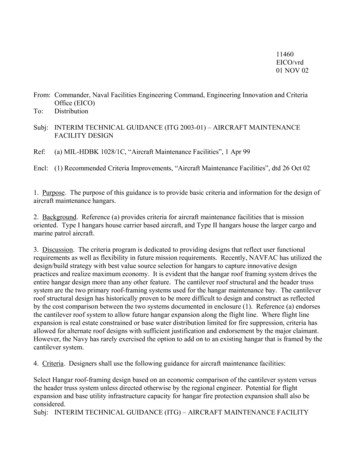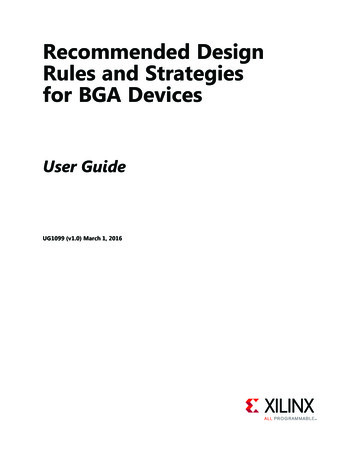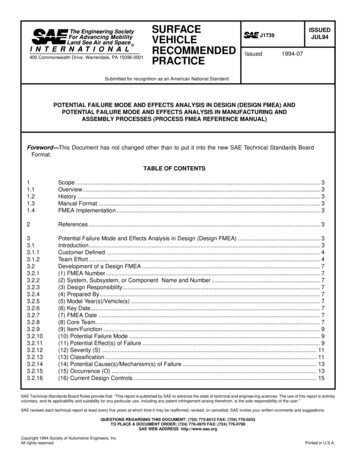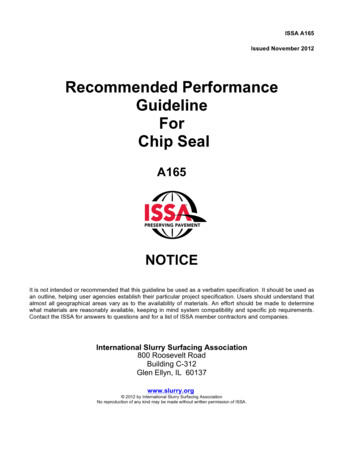
Transcription
ISSA A165Issued November 2012Recommended PerformanceGuidelineForChip SealA165NOTICEIt is not intended or recommended that this guideline be used as a verbatim specification. It should be used asan outline, helping user agencies establish their particular project specification. Users should understand thatalmost all geographical areas vary as to the availability of materials. An effort should be made to determinewhat materials are reasonably available, keeping in mind system compatibility and specific job requirements.Contact the ISSA for answers to questions and for a list of ISSA member contractors and companies.International Slurry Surfacing Association800 Roosevelt RoadBuilding C-312Glen Ellyn, IL 60137www.slurry.org 2012 by International Slurry Surfacing AssociationNo reproduction of any kind may be made without written permission of ISSA.
RECOMMENDED PERFORMANCE GUIDELINE FOR CHIP SEAL1. SCOPEThe intent of this guideline is to aid in the design, testing, quality control, measurement and paymentprocedures for the application of a Chip Seal Surface.2. DESCRIPTIONChip seal shall consist of a uniform spray application of an asphalt binder followed by a uniform application ofa graded cover coat aggregate which is then rolled with pneumatic tire rollers over a properly preparedsurface. Excess aggregate is removed and an optional application of fog seal (emulsified asphalt) may beapplied.3. SPECIFICATIONSIt is not normally required to run all tests on every project. A compilation of results from the listed tests shouldbe indicative of system performance. Failure to meet the specification for an individual test does notnecessarily disqualify the system. If, for example, the system to be used on the project has a record of goodperformance, individual requirements for testing may be waived. The testing methods are listed in Appendix Aand form a part of this guideline.4. MATERIALS4.1ASPHALT BINDER4.1.1EMULSIFIED ASPHALT BINDERThe emulsified asphalt shall contain asphalt, water, emulsifier, and may contain polymer.When polymer is used, it is typically recommended that the emulsified asphalt contain threepercent (3%) polymer solids based on asphalt weight. It shall be pumpable and suitable forapplication through a distributor truck. Examples of emulsified asphalt classifications mayinclude RS-2, RS-2h, HFRS-2, CHFRS-2P, CRS-2, CRS-2h, CRS-2P (SBS), CRS-2L (LM).Emulsified asphalt shall meet the requirements listed in Section 5.2.1.4.1.2HOT ASPHALT BINDERThe asphalt may be modified or non-modified. The asphalt shall be heated to a point where itis pumpable and suitable for application through a distributor truck. Examples of asphaltclassifications are: PG 52 -28, PG 58 -28, PG 64 -22.4.2COVER COAT AGGREGATE4.2.1 GENERALThe cover coat aggregate used shall be the type specified for the particular applicationrequirements of the chip seal. The cover coat aggregate shall be clean, durable stone suchas granite, slag, limestone or other high-quality aggregate.The shape and quality of the cover coat material is important to the successful application andperformance of a chip seal. A hard, crushed, single size aggregate with 100% fractured facesis recommended. Aggregate meeting requirement locks together and provides better longterm retention and stability.2
4.2.2 GRADATIONWhen tested in accordance with AASHTO T 27 (ASTM C 136) and AASHTO T 11 (ASTM C117), the aggregate gradation shall be within one of the following bands (or one recognized bythe local authority).SIEVESIZETYPE I1/4" (6.4 mm)Percent PassingTYPE II3/8” (9.5 mm)Percent PassingTYPE III1/2” (12.5 mm)Percent Passing3/4” (19 mm)1001001001/2” (12.5 mm)10010095-1003/8” (9.5 mm)10095-1000-151/4” (6.4 mm)95-1000-350-10#8 (2.36 mm)0-3.00-3.00-3.0#200 (75 µm)0-1.00-1.00-1.04.2.3 QUALITY TESTSThe cover coat aggregate should meet the values specified by the Buyer’s AuthorizedRepresentative (B.A.R.). See Section 5.2.3.5. LABORATORY EVALUATION5.1GENERALBefore work begins, the Contractor shall submit the signed certificate(s) of analysis covering thespecific materials to be used on the project. System component quality tests will be performed by alaboratory which has experience in designing asphalt chip seals. Once the design has been approved,no material substitution will be permitted unless approved by the B.A.R.The method of mix design shall be specified by the B.A.R. The mix design shall specify targetapplication rates for both the aggregate and binder as well as permissible operating tolerances so thatadjustments may be made due to varying field conditions.5.2QUALITY TESTS5.2.1 EMULSIFIED ASPHALTThe emulsified asphalt and emulsified asphalt residue shall meet the requirements of ASTM D977, AASHTO M 140, ASTM D 2397, and AASHTO M 208 for emulsion. Recommended testsand values are as follows:TEST METHODAASHTOASTMTESTTests on Emulsified AsphaltResidue (Oven Evaporation), %Residue (Distillation), %Viscosity, Saybolt Furol, 122 F (50 C ), sfsStorage Stability, 24 Hr, %Sieve, %Demulsibility (RS-2, HFRS-2, RS-2P, CRS-2P)Demulsibility (CRS-2, CRS-2h, CHFRS-2P)Tests on Emulsified Asphalt ResidueDuctility, 77 F ( 25 C ), 5 cm/min, cmPenetration in dmm, 77 F (25 C), 100g, 5sElastic Recovery, 5 cm/min, % (other testparameters are area specific)3SPECIFICATIONT 59T 59T 59T 59T 59D 6934D 6997D 7496D 6930D 6933T 59D 6936T 51T 49D 113D540 Minimum(Area Specific)T 301D 6084(Area Specific)65 Minimum100 – 4001.0 Maximum0.1 Maximum40% Minimum60% Minimum
Each load of emulsified asphalt shall be accompanied with a Certificate of Analysis(COA) or Certificate of Compliance (COC) to insure it meets the above specifications.5.2.2 ASPHALTThe asphalt shall meet the requirement of AASHTO M 320 (Performance-Graded AsphaltBinder), AASHTO M 226 (Viscosity-Graded Asphalt Cement), or AASHTO M 20 (PenetrationGraded Asphalt Cement) specification. Examples of commonly used asphalt types:Performance-GradedAsphaltViscosity-Graded AsphaltPenetration-GradedAsphalt [dmm, 77 F(25 C), 100g, 5 sec]AC - 2.5PG 52 -28PG 58 -28PG 64 -225.2.3AC - 5AC - 10AC - 20150 - 250100 - 15060 - 80COVER COAT AGGREGATEThe cover coat aggregate should meet values specified by the B.A.R. and these minimumrequirements:TEST METHODTESTSPECIFICATIONAASHTOFlat and elongated particles in covercoat aggregateASTMD 4791Ratio of 3:1 12%Fractured FaceT 335D 5821100%Resistance to Degradation of SmallSize Coarse Aggregate by Abrasionand Impact in the Los AngelesMachineT 96C 13125% Maximum6. EQUIPMENT6.1GENERALAll equipment, tools, and machines used in the application of chip seal shall be maintained insatisfactory working conditions at all times.6.1.1ASPHALT DISTRIBUTORThe distributor shall be self-powered and capable of providing a uniform application rate of22asphalt binder varying from .05-1.00 gal/yd (0.23-4.5 liters/m ) over a variable width up totwenty feet (six meters) in a single pass. The uniformity of the distributor shall not vary by22more than 0.02 gal/yd (0.09 l/m ). It shall be equipped with a variable power unit for thepump and full circulation spray bars, which are adjustable laterally and vertically. Thenozzle angle and bar height shall be set to provide 100 percent of double coverage in asingle pass. Where multiple passes will be required to complete the full width, the fourinches (ten centimeters) adjacent to the second pass may be left with 50 percent coverageso that the next pass will complete the full application rate specified. The distributor shall beself-powered and include computerized application controls, a tachometer, pressuregauges, accurate volume devices, calibrated tank, and a thermometer for measuringtemperatures of the emulsified asphalt in the tank.4
6.1.2 CHIP SPREADERThe machine shall be specifically designed and manufactured to apply various types ofaggregate. It shall be self-propelled and supported by at least four tires on two axles capable22of providing a uniform application rate of aggregate from 5-50 lbs/yd (2.7-27 kg/m ) over avariable width. It shall be designed to convey aggregate materials from a rear receivinghopper to a front spread hopper. The front spread hopper will be fixed width or variable width.The machine shall apply this aggregate in a uniform pattern across the entire width of thespread hopper regardless of spreading widths. The application rates will remain consistentregardless of the speed of the machine or changing spread widths. This shall be done withcomputer controls that monitor the ground speed and adjust the spread hopper rate in22relationship to ground speed. Application rates will be preset in lbs/yd (kg/m ).6.1.3 PNEUMATIC ROLLERSA minimum of two self-propelled pneumatic tired rollers shall be used on the project unlessotherwise requested by the Project Manager. The rubber tired rollers shall have a gross loadadjustable to apply 200-250 psi (1379-1724 kPa) of rolling width. Tire pressure shall bespecified for the pneumatic tire rollers and shall not vary more than plus or minus 5.0 psi (34.5kPa). Depending on the speed of the chip seal operation and the width of coverage, additionalrollers may be required. It is recommended that the rollers travel no more than 10 miles perhour.6.1.4 SWEEPERSSelf-propelled four wheeled rotary mechanical brooms and or vacuum brooms capable ofoperating in both forward and reverse is recommended. Brooms should be checked to ensurethey are in good condition and meet applicable environmental standards.7. CALIBRATIONThe distributor and chip spreaders shall be calibrated to assure the proper amount of binder and aggregateare applied. The calibration shall consist of assuring mechanical and electronic components are set correctlyand in good operation order. Distributors should be checked for proper nozzle size. Manufacturers of theequipment can provide detailed instructions for calibration procedures.8. WEATHER LIMITATIONSThe chip seal shall not be applied when the pavement is moist, or when the weather is, or may be, detrimental.Detrimental weather is defined as rain showers, cool temperatures, moist pavements, threat of rain showers,or other environmental factors which could affect the performance of the chip seal construction. No chip sealshall be applied if either the pavement or air temperature is below 60 F (15.5 C) and falling, but may beapplied when both pavement and air temperatures are above 60 F (15.5 C) and rising. Temperatures rangesshould be adjusted for regional climates.9. NOTIFICATION AND TRAFFIC CONTROL9.1NOTIFICATIONHomeowners and businesses affected by the construction shall be notified at least one day in advanceof the surfacing. Should work not occur on the specified day, a new notification will be distributed. Thenotification shall be in the form of a written posting, stating the time and date that the surfacing willtake place. If necessary, signage alerting traffic to the intended project should be posted.5
9.2TRAFFIC CONTROLA traffic control plan approved by the B.A.R. will be required before any work begins. Temporaryraised pavement markers will be installed as needed, at a minimum of 40 foot (12 meter) spacing.The cost of signage, markers and traffic control necessary to complete this project shall be included inthe unit price of the chip seal. Traffic control devices shall be in accordance with agency requirementsand, if necessary, conform to the requirements of the Manual on Uniform Traffic Control Devices.10. SURFACE PREPARATION10.1GENERALImmediately prior to applying chip seal, the surface shall be cleared of all loose material, silt spots,vegetation, and other objectionable material. Any standard cleaning method will be acceptable. Ifwater is used, cracks shall be allowed to dry thoroughly before applying chip seal. Manholes, valveboxes, drop inlets and other service entrances shall be protected from the chip seal by a suitablemethod. The B.A.R. shall approve the surface preparation prior to surfacing.10.2CRACKSIt is recommended to treat cracks wider than 0.25 in (0.64 cm) in the pavement surface with anapproved crack sealer prior to application of the chip seal.10.3PATCHINGPrior to the chip sealing operation all failed pavement sections should be removed and patched. Theperimeter of excavated areas should be milled or saw cut to form a neat vertical face. Unstable areasof sub-grade should be back filled with well graded and compacted aggregate. Asphalt concreteshould then be placed, leveled and compacted to form a smooth and bump free surface.11. APPLICATIONS11.1APPLICATION OF ASPHALT BINDERAsphalt binder shall be applied by means of a pressure distributor. Application shall be a uniformcontinuous, full coverage spread, and under such pressure as to thoroughly coat the surface at thespecified rate. The forward speed of the distributor truck shall be synchronized with the application ofthe cover coat aggregate. Asphalt binder shall not be applied on a wet surface or when weatherconditions would prevent the proper construction of the chip seal.11.2APPLICATION OF COVER COAT MATERIALThe cover coat material should be applied immediately following the asphalt binder application. The22quantity of cover coat aggregate per yd (m ) shall be specified and agreed upon with the B .A.R. TheContractor, prior to start of work, shall calibrate the aggregate spreader to achieve the designapplication rate of the cover coat aggregate. Spreading shall be accomplished in such a manner thatthe tires of the trucks and aggregate spreader never contact the newly applied asphalt binder. Thewidth of the aggregate spreader shall be equal to the width of the asphalt binder coverage, exceptwhere additional passes are required. Areas which are deficient in aggregate shall be coveredimmediately with additional cover coat aggregate.6
11.3ROLLINGInitial rolling shall begin immediately after the application of the cover coat aggregate. Rollers shallwork in tandem and complete a minimum of three passes with a sufficient overlap. Should the rollingopera
When tested in accordance with AASHTO T 27 (ASTM C 136) and AASHTO T 11 (ASTM C 117), the aggregate gradation shall be within one of the following bands (or one recognized by the local authority). SIEVE SIZE TYPE I 1/4" (6.4 mm) Percent Passing TYPE II 3/8” (9.5 mm) Percent Passing TYPE III 1/2” (12.5 mm) Percent Passing 3/4” (19 mm) 100 100

